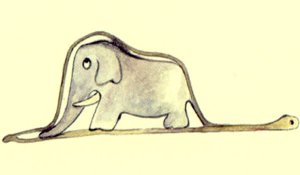Divergent Thinking: What It Is and How to Develop It


Written and verified by the psychologist Valeria Sabater
Divergent thinking, or lateral thinking, is about generating multiple creative solutions to the same problem. It is a spontaneous, fluid, non-linear mental approach based on curiosity and nonconformity. In fact, it is also a type of thinking very common in children, where joy, imagination, and a fresh perspective make their reasoning more free.
Divergent thinking is important in today’s modern world. In a society accustomed to mimicking similar skills, there comes a time when large companies begin to value other skills. Other dimensions that bring ingenuity and vitality to their projects. Thus, a person capable of offering innovation and creativity can make an attractive candidate.
However, our schools and universities still prioritize a very convergent type of thinking in their methodology. In the 1960’s J.P. Guilford differentiated and defined convergent and divergent thinking.
“Creativity is intelligence having fun.”
-Albert Einstein-
Although Guilford emphasized the importance of training children in divergent thinking, educational institutions have paid little attention to him. In general, they’ve prioritized a type of reflection (or rather lack thereof) where the student must use linear thinking, rules, and structured processes to come to the one “right” solution.
While in many cases, this strategy is useful and necessary, we must admit that real life is complex, dynamic, and imprecise enough that it’s unrealistic to think that problems have only one solution. Therefore, we need to learn how to use true divergent thinking.
Many educational centers do encourage their students to do more than find the right answer. There, the goal is to be able to create new questions.

Divergent thinking and psychological processes
Before continuing, it would be good to clarify one idea. No one kind of thinking is better than another. Convergent thinking is useful and necessary on many occasions. However, the real problem is that we’ve been “trained” to only think this way. We’ve neglected spontaneity, wit, and captivating freedom.
In many courses aimed at training people in divergent thinking, students are asked questions like the following:
- What kind of things could you do with a brick and a pen? What kind of uses could you come up with if we gave you a toothbrush and a toothpick?
At the beginning, it may be hard to come up with even one idea. However, some people are capable of coming up with multiple answers and ingenious ideas because they are good at what Edward de Bono calls “lateral thinking”. To understand how this works a little better, let’s see what kind of psychological processes come into play.

Semantic networks, or the theory of connectivity
Divergent thinking is the capacity to find relationships between ideas, concepts, and processes that, at first glance, lack any similarity. Psychologists who are experts in creativity say that people have different mental networks of association:
- People with “steep” semantic networks are governed more by logic and linear thinking.
- People with “flat” semantic networks have mental networks that are much more connected. That is, sometimes they relate two things to each other that don’t make sense but other networks contribute and an ingenious idea results.
Right and left brain
We have all heard about how the right hemisphere of the brain is the creative side and the left is the logical side. Therefore, according this theory, people who use more divergent or lateral thinking will more often use the right hemisphere. Well, we have to be careful with this kind of generalization about lateralization or cerebral dominance. Because actually it is a very nuanced process.
We can’t see the brain as an entity with clearly separated areas. In fact, when generating an idea, whether it is ingenious, conservative, logical, or highly creative, we use our whole brain. The key lies is in how we connect one idea to another. The most ingenious people use tree-like thought processes. In other words, they are making connections in both sides of the brain, not just one.
“Imagination is the beginning of creation. You imagine what you desire, you will what you imagine, and at last you create what you will.”
-George Bernard Shaw-

How can I train myself in divergent thinking?
Like we said, all of us, regardless of age, can practice and improve our divergent thinking. To do so, we will focus on four areas in particular:
- Fluency: the ability to produce a large number of ideas.
- Flexibility: the ability to create a wide variety of ideas based on different fields of knowledge.
- Originality: the ability to create innovative ideas.
- Development: the ability to improve our ideas, to make them more sophisticated.
Now here are four ways to improve the four areas above:
Synectics exercises
“Synectics” is a term coined by psychologist William J. J. Gordon. Basically, it means being able to find connections and relationships between concepts, objects, and ideas that seem unrelated. This exercise takes a lot of mental work. We can do it daily by choosing the concepts ourselves. For example:
- What can I do with a paper clip and a spoon?
- What relationship could there be between the Limpopo River in Africa and Lake Baikal in Siberia?
The Scamper technique
The Scamper technique is another creative idea-developing strategy developed by Bob Eberle. It is very useful in creating something innovative and practicing divergent thinking. For example, let’s say we have to come up with an idea for work. Once we have that “idea”, we’ll put it through a series of “filters”.
- Substitute one element of that idea for another. (What can we change in how we have fun? And in how we work?)
- Now combine everything (What can we do to make our work more fun?)
- Adapt it (What do people do to be less stressed at other workplaces?)
- Modify it (How can we work without becoming stressed?)
- Give it other uses (What is there at work that I could do in a more fun way?)
- Eliminate something (What if you get to work a little earlier to make better use of the day?)
- Reform it (What would happen if I dared to…?)

Divergent thinking and your mood
Psychologist Nina Lieberman’s research in the very interesting book Playfulness: Its Relationship to Imagination and Creativity has something very relevant to add to this discussion. Divergent thinking goes hand-in-hand with joy, optimism, and inner well-being. Having good relationships, being well-rested, and being free of pressure, anxiety, and stress puts you in an ideal position for divergent thinking.
With our high-pressure, busy lives, we neglect many of these valuable dimensions. Therefore, we could also conclude that this type of thinking is also born out of a certain attitude towards life: free, cheerful, nonconformist, open to new experiences…
All cited sources were thoroughly reviewed by our team to ensure their quality, reliability, currency, and validity. The bibliography of this article was considered reliable and of academic or scientific accuracy.
Bono, Edward (2014) Lateral Thinking: An Introduction. UK: Vermilion
Runko, A. Mark (1991) Divergent Thinking (Creativity Research). Creativity Research
This text is provided for informational purposes only and does not replace consultation with a professional. If in doubt, consult your specialist.








